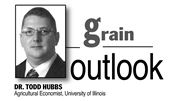Summer Pricing For Corn And Soybeans

Recent corn and soybean price declines associated with the political situation in Brazil erased the slight gains since the release of the March 31 Prospective Planting report. The sudden drop gives an indication of the fragility of the current soybean market, in particular. The information in the USDA’s May 10 WASDE report is already incorporated into prices and the possibility of weather-related price runs in the summer are in focus. The following factors bear watching for possible pricing opportunities during the summer months for soybeans and corn.
In the soybean market, an indication of increasing consumption but larger ending stocks associated with increased production create an expectation of declining prices for the summer months barring a severe weather event. One factor of note is the large South American soybean crop and the potential impact on U.S. soybean exports. Currently, soybean exports are ahead of the pace needed to meet the projection of 2.05 billion bushels for the 2016-17 marketing year. Brazilian production is up approximately 12 percent in 2017 over last year's crop at 8.48 billion bushels and projected production for the 2018 crop is at 8.41 billion bushels. To date, Brazilian exports have been sluggish but the rapid drop in the Brazilian Real last week brought increased sales by Brazilian farmers. Weekly exports of U.S. soybeans may weaken under the increased competition. The large Brazilian crop looks to place downward pressure on exports in the summer months.
U.S. soybean planted acreage and yield will be key factors in soybean prices this summer. The release of the June 30 acreage report could be particularly bearish for soybean prices. The U.S. average soybean yield is projected at 48 bushels per acres with 89.5 million planted acres reported in USDA's Prospective Planting report. The cold and wet planting season in the Corn Belt with numerous reports of replanting of corn could lead to an increase in planted acres in soybeans for the 2017 crop year. Soybean plantings in the May 15 report sat at 32 percent which is on pace with the five year average. If there is a lack of prevented planted acreage, the prospect of soybean acreage exceeding intentions looks more likely.
Corn prices this summer will be impacted by export progress and production issues. Current corn export levels are running above the pace to meet the projected 2.225 billion bushels for the 2016-17 marketing year. South American corn production recovered in 2017 from the drought-plagued 2016 crop year with Brazilian corn production projected at 3.78 billion bushels and Argentinian production projected at 1.57 billion bushels. The corn crop in South America will be entering the market this summer and will provide stiff competition for U.S. exports.
U.S. corn yield and production will be key to possible corn price runs in the summer. The U.S average corn yield is projected at 170.7 bushels per acre, and prospective planted acreage is at 90 million acres. While it is too early to deduce the impact of the poor planting season on corn yields and acreage choices, there exists the potential for lower yields in corn than in the last three years. The crop progress report on May 15 showed corn planting catching up to normal planting levels after a slow start. The first crop condition report by the USDA bears watching. Corn acreage may also be less than indicated in the Prospective Plantings report.
Risks associated with waiting for a summer price rally before pricing the 2017 crop is larger for soybeans. It may be prudent to price soybeans if a rally occurs in June before the release of the June acreage report. There is likely less risk of lower corn prices for several reasons. Soybean acreage is more likely to surpass planting intentions creating a scenario in which production could be large even with a modest yield loss. Soybean yields may also be less vulnerable to problematic summer weather than corn. Soybean prices appear more vulnerable to downward price movements given large current supplies and the expectation of a large crop in 2017. Fundamental supply and demand factors are supportive to corn prices for the 2017-18 marketing year with the expectation of smaller production and reduced ending stocks.
If a summer rally in prices occurs, producers should consider aggressively pricing the 2017 soybean crop. A weather market may produce larger price increases for corn. The price decline that occurred last week on one piece of political news out of Brazil provides an indication of just how precarious soybean prices are currently. The weather experienced thus far in the crop year may foretell the potential for weather rallies through the summer months, but the fundamentals underlying both crops indicates a greater risk in soybean prices. ∆
DR. TODD HUBBS: Agricultural Economist, University of Illinois